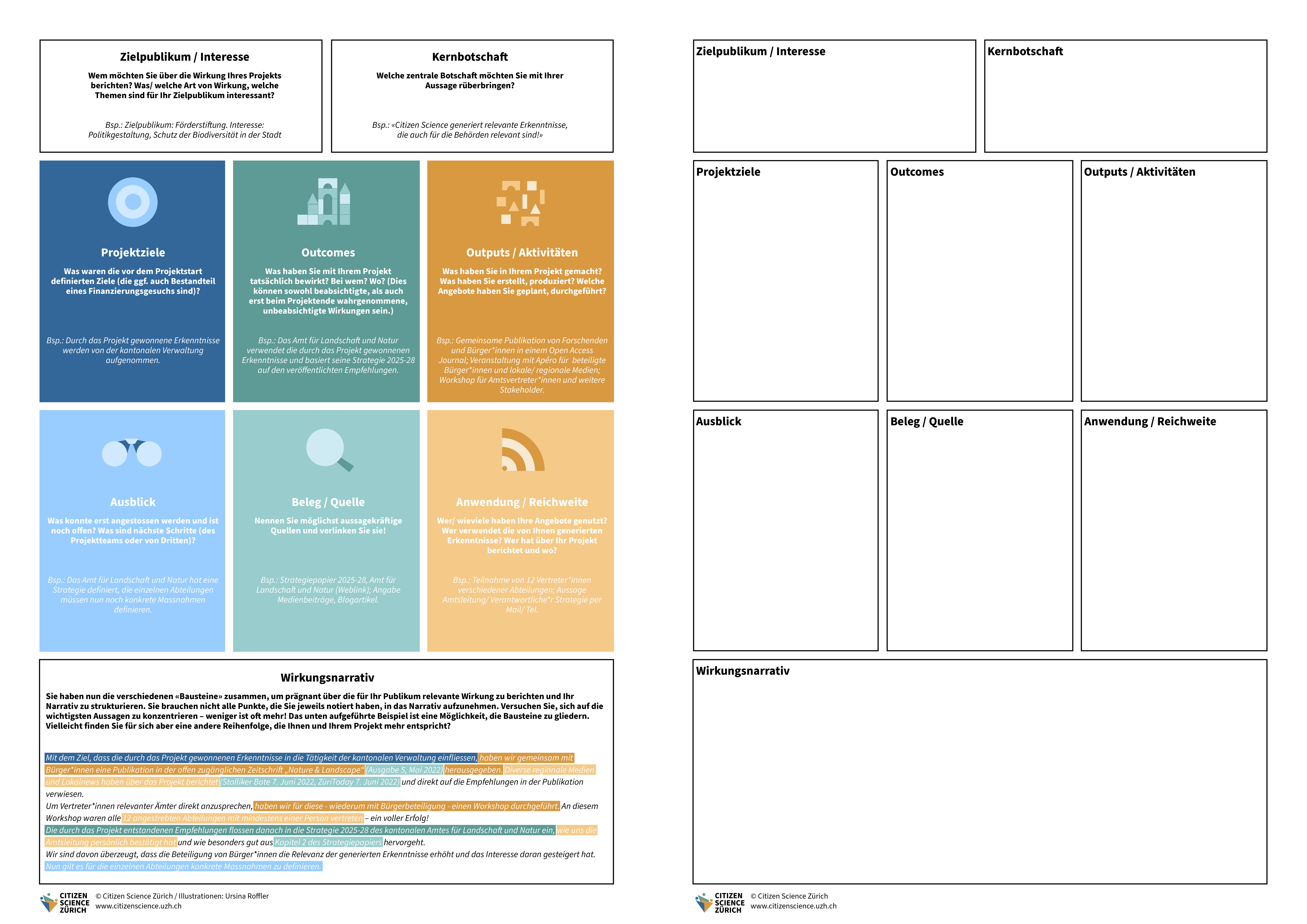Template for Impact Narrative
At the CitSci Helvetia ‘23 in Solothurn as part of our workshop "Big words, big impact? Wirkung benennen und sichtbar machen", we took a closer look at the potential impact of Citizen Science together with conference attendees.
Because: Identifying and visualizing impact is challenging. Particularly where a project is intended to have an impact at a societal level or in local ecosystems, concrete results can only be measured years later. If the first indicators of an impact beyond the immediate project creation become apparent early on, it can still be challenging to substantiate this convincingly and with concrete evidence.
So-called buzzwords such as "sustainability", "empowerment" or "community" are therefore quickly resorted to. The advantage? Buzzwords sound good and are universally known, so they don't need any further underpinning. The disadvantage? We often remain vague in our wording, raise all kinds of unspoken expectations and, at the end of the project, it is difficult to say whether we have achieved our goals or what contribution our project has made. What makes communication easier for us in the short term, makes it more difficult for us to provide well-founded reporting after the project has been completed. But how can the impact of a project be made visible and communicated well?
With our template for your impact narrative, we want to raise awareness of the impact of Citizen Science and help project managers to communicate this in a concise and target group-specific way. Because: Every Citizen Science project achieves impact at different levels and for different groups of people! Different goals or areas of impact have priority for science than for participating citizens, NGOs or funding foundations. Therefore, we advise:
- Target Audiences: Focus on the most relevant effects for the target group. True to the motto: less is more! And communicate in a target group-oriented way, both in terms of content, language and the media and channels used. This means that you need to think about "where" your target group is active.
- Project Objectives: When planning your project, think about the specific impact you want to achieve with your project and how you can quantify it.
- Outcomes: Communicate concrete, measurable and demonstrable effects resulting from your project.
- Outputs: Mention not only what contribution you have made, but also what citizens involved have contributed to the success of the project!
- Application / Reach: Can you involve citizens participating in the project in making the impact of your project visible? All the better!
- Document / Source: If possible, name sources that refer to and mention the outcomes you are communicating. If possible, link directly to media articles, blog posts, partner websites, etc. instead of "only" mention them.
- Outlook: An outlook always indicates the sustainability of a project. Not only in an ecological sense, but also in a social sense. What structures have been created that will last beyond the duration of the project? Which services will be taken over and continued by third parties?
- Key Message: Finally, check whether your key message really comes across in your report!
Important: Our template is intended as a support. On page 1 of the document (in color) you will therefore find an explanatory helper text and an example for each box. Page 2 of the document (in black and white) is intended for you to fill in. You may not be able to clearly separate the contents of all the boxes. Do not let this unsettle you.
For our template for the impact narrative, we looked at the work of Giovanna Lima and Sarah Bowman (Trinity College Dublin) and Wehn, U., Gharesifard, M., Ceccaroni, L. et al. (MICS). In addition, we base our template on the I-O-O-I impact logic used by Dr. Urs Müller in the workshops on impact-oriented project planning. To use the template, we therefore recommend that you familiarize yourself with the common terms of impact logic.
We have revised the template based on the feedback from the above mentioned workshop. We would like to take this opportunity to thank everyone for their participation in the workshop!
References:
- Lima, G. and Bowman, S. (2022). Researcher Impact Framework: Building Audience-Focused Evidence-Based Impact Narratives. Trinity College Dublin. [pdf] Dublin. https://doi.org/10.25546/98474
- Wehn, U., Gharesifard, M., Ceccaroni, L. et al. (2021). Impact Assessment of Citizen Science: State of the Art and Guiding Principles for a Consolidated Approach. Sustain Sci 16, 1683–1699. https://doi.org/10.1007/s11625-021-00959-2

